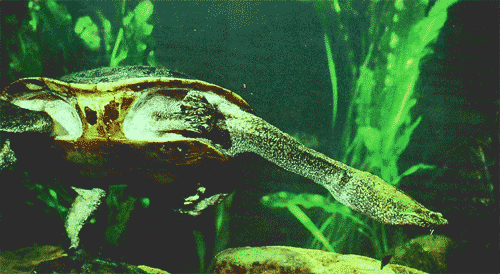Arnhem Land Long Neck Turtle -- Macrochelodina burrungandjii
by Scott Thomson.
 This species was described in 2000 by Arthur Georges, Rod Kennett and myself and was named using the Gagadju People's word for the species. This description applied a name to what was clearly a different species separating it from the lowland Macrohelodina rugosa or the Northern Snakeneck Turtle.
This species was described in 2000 by Arthur Georges, Rod Kennett and myself and was named using the Gagadju People's word for the species. This description applied a name to what was clearly a different species separating it from the lowland Macrohelodina rugosa or the Northern Snakeneck Turtle.
In the wild this species is restricted to the Arnhem Land Escarpment region of the Northern Territory in Australia however there is a population of Macrochelodina in the escarpment Territory of Western Australia also, which is very similar if not an isolated population of the same species. In the paper we were able to diagnose these two isolated populations in that the Arnhem Land form consistently has a contiguous set of neural bones, whereas the Western Australian form does not.
This species has an extremly wide, flattened and shortened skull, for a snake neck, in fact it is reminiscent of the Mata Mata in this feature. This would seem to be a function of its feeding method, this turtle is an extremely efficient and deadly piscavore. It is capable of lightning fast sideways strikes at fish and is one of the few long necks that if you are bitten it will hurt you.
The picture was taken for us by John Cann and he kindly gave us permission to use it in the description. I will be uploading the entire paper for people to look at shortly it is an interesting read as this species is quite unique even among the Macrochelodina. Having kept this species I have found it to do best at high pH conditions in relatively shallow water. In the wild it lives in the Limestone escarpment country of Arnhem Land and is hence tropical.
Distinguishing this species is relatively easy as it tends to have a broad flat head compared to other species of Macrochelodina. The carapace is oblong in general appearance and hence differs from the anterior narrowing seen in Macrochelodina rugosa. Macrohelodina burrungandjii tends to be larger in size than M. rugosa and has a larger head. It is also far mor brightly coloured with only M. parkeri having a more colourful head pattern. Other more definitive methods can be obtained from the description (Thomson, et al., 2002).
My recommended keeping methods for the species are identicle to Macrochelodina rugosa It certainly seems to do well as long as good water quality, high pH and attention to diet is maintained.
Major Reference:
Thomson S., Kennett R. and Georges A. (2000). A new species of long necked turtle (Chelidae:Chelodina) from the sandstone plateau of Arnhem Land, Northern Australia. Chelonian Conservation and Biology 3:675-685.
